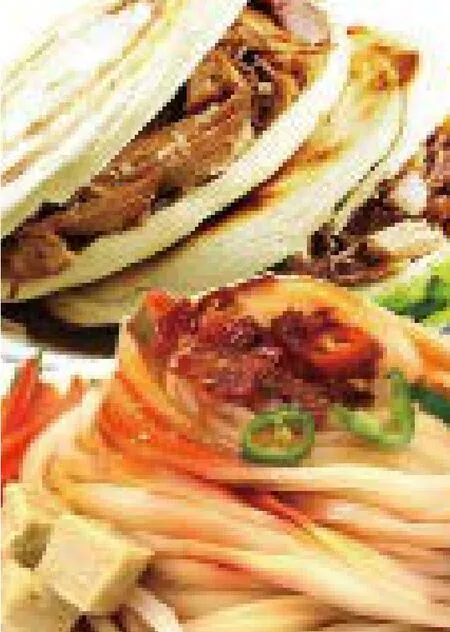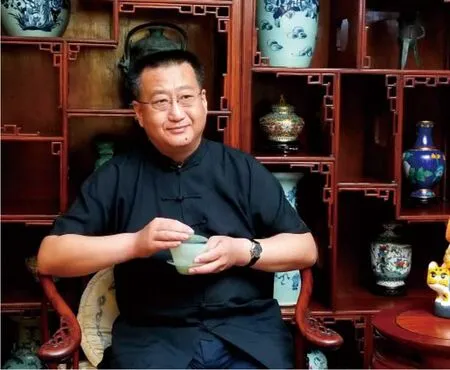舌尖上的丝绸之路
舌尖上的丝绸之路
Silk Road on the Tip of the Tongue



《舌尖上的中国》曾在海内外热播,打开了人们的味蕾。作家、文化学者崔岱远老师对美食的掌故熟稔于心,他的著作《吃货辞典》入选“中国影响力图书”“中国好书”,被誉为接地气的好作品!本期“国际朋友说”特邀嘉宾崔岱远邀请国际朋友来到北京贵宾楼饭店玉兰厅,聊一聊那些通过丝绸之路流传到国外的中国食物,以及那些通过丝绸之路来到中国的外国食物,一起分享食物源流和演变的“舌尖上的丝绸之路”。
The program “China on the Tip of the Tongue”, which has gone viral both in the country and abroad, has revealed the taste of China to people. Writer and scholar Cui Daiyuan's, Dictionary of a Foodie, has been included in the China’s Most In fl uential Books and China Loves Reading collections, and has become famous for its “down-to-earth”narration. This time, scholar Cui was invited as a special guest for “World Speaking”, an event held at Grand Hotel Beijing, to give a talk on what food from China was exported to other countries along the ancient Silk Road route, and to discuss the food origins and how “Silk Road on the Tip of the Tongue” evolved.
主持人(Host):吴星铎,中国(Wu Xingduo,China)
嘉宾(Guests):苏莉,俄罗斯(Anastasia Sukhoretskaya,Russia);吴求,孟加拉国(Shayer S. Utsho, Bangladesh)
特邀嘉宾(Special Guest):崔岱远(Cui Daiyuan)
(作家,文化学者,北京读书形象大使,首都图书馆荣誉馆员,北京阅读季首批领读者培训师,全国读书会联盟导师,现任中国财政经济出版社副编审。系列作品《京味儿》《京味儿食足》《京范儿》引领人们循着文字感受京城民间最本真的性情气韵。《吃货辞典》入选“中国影响力图书”“中国好书”,被誉为接地气的好作品。)(Special Guest Cui Daiyuan is a writer, culture scholar, Beijing book reading image ambassador, Capital Library honorable librarian,trainer during the Beijing reading season, supervisor of National Readers Union, and subeditor of China Finance and Economics publishing house. Cui was elected as a main expert during the 12th, 13th and 14th Beijing International Book Festival, a guest at CCTV, CNRS and China Education Channel. Cui has published The Taste of Beijing, Abundance of Beijing Taste, and Beijing Style, all of which introduce the real taste of the capital.His book, The Dictionary of a Foodie, has been selected to be in the China’s Most In fl uential Books and Recommended Books of China collections.)
书斋趣话
主持人:话题还是从丝路开始,谈到丝绸之路,大家脑海中首先浮现的是什么形象?
吴求:第一个画面会是很长一条弯弯曲曲的路,一队人骑着骆驼,走啊走啊。
苏莉:第一画面会是丝绸,因为是丝绸之路。
崔岱远:丝绸之路是一个相当长的历史时期,是一个广阔的时空。其实丝绸之路和中国人关系最大的不是丝绸,而是饮食。说到饮食,就不得不提小麦。小麦这种原始植物产生于两河流域,现在的考古学家还在叙利亚发现过炭化的小麦粒。经过相当长的一段时期,小麦本身的品种也进行了许多演化,才传到了今天的新疆进行种植。小麦什么时候穿越河西走廊来到内地中原的呢?这是个漫长的过程,西周历史典籍《穆天子传》里有记载说,周穆王从一个西域女性氏族首领那里得到麦子运回镐京,所以才有了撒在八百里秦川上的小麦种子。直到今天,陕西仍是小麦的主产地,而且质量特别好。在那个时候,人们以小麦为主食,吃的肉主要是羊肉。
主持人:这让人联想起一碗热腾腾的羊肉泡馍。
崔岱远:是这样的,羊肉泡馍相当于把饼撕碎了泡在水里吃,而我们熟知的饼,其实也不是中国人发明的,是西域传过来的。今天你到伊朗、伊拉克,那里的人也吃在饼铛上烤的大饼。传到新疆的时候叫馕,这个词是波斯语。再传到中原就叫胡饼了,《汉书》上说汉灵帝喜欢新鲜玩意,喜欢吃胡饼,结果当时京城里就很多人吃胡饼,就跟现在吃西餐一样,赶时髦。到了唐朝的时候,长安城里到处都是卖胡饼的。
主持人:小麦是舶来品,那么中国的面食是不是原创?或者也是从西域传来的?
崔岱远:面食的确是中国人发明的。东汉时代,石磨开始普及了,人们开始把小麦磨成面。怎么吃呢?中国人不会烤面包,就是加点水,和成团,把面揪成一块一块的搁水里煮,就变成煮揪汤片了,直到现在陕西还在吃这个,这就是面条的祖宗,但它不叫面条,叫汤饼。因为在中国古汉语里把开水叫作汤。这么一来,面条就出现了,所以,面条是从中国发源的。因为在揪面的时候,揪着揪着发现里面有一个东西叫面筋,面筋实际是两种蛋白质,它有延展性和弹性,能抻回来抻回去,抻着抻着就成面条了。最早做面就是拿水和面,后来发展到拿鸡汤和面,抻成韭菜似的那么长那么细,然后拿热气一熏,再下锅煮,这个就是《齐民要术》上说的水引饼。
主持人:在中国,不同地方的面条也是各有特点。
崔岱远:没错:甘肃的面条是面条的最原始状态——拉面,兰州当地叫它牛肉面。顺着黄河到了陕西,面条就更有中原气息了,出现了裤带面和Biángbiáng面。等到了山西,面条种类数以千计,山西的面条不只是白面,还有高粱面、豆面的。
主持人:那么,面条是不是被马可·波罗传到欧洲才变成意大利面的?
崔岱远:你说对了一半,意大利面是中国的面条传过去的,但不是马可·波罗带过去的,因为在马可·波罗出生前10年,意大利就有关于意大利面的记载了。具体怎么传过去的有两种说法,一种是唐代时阿拉伯商人来长安做生意,发现长安人吃面条,就像咱们到了纽约发现人家在吃麦当劳似的,于是就把它带回去了。有意思的是途中经过沙漠,面条自然就干了,回去之后拿水一泡,煮煮就吃了。所以意大利人以为面条都是干的。另一种说法是,海上丝路的终点就是意大利的西西里岛,研究发现最早吃意大利面的地方就在西西里岛,而在中国南宋的时候西西里岛是被阿拉伯人统治的,现在教堂上还挂着阿拉伯的画,阿拉伯人由于宗教问题没有把筷子传过去,所以意大利面是用刀叉吃的。
各地饮食特色
Biángbiáng面是陕西关中特色传统风味面食,是传统的陕西裤带面。特指关中麦子磨成的面粉,通常手工拉成长宽厚的面条。由上等面粉精制而成,用酱油、醋、味精、花椒等佐料调入面汤,捞入面条,淋上烧热的植物油即成。来自孟加拉国的吴求当场展示“Biáng”字笔画书写,得到了主持人、嘉宾和国际朋友们的一致赞许。
主持人:你们国家有哪些食物是从中国来的?
吴求:面食是中国来的,这点我知道。在孟加拉国我们的主食是大米和米饭。面条的话,受西方的影响,我们习惯吃干面。但我早就猜到它来源于中国。我见过中国厨师们做拉面,这样拉来拉去,拉个没完也不断,就觉得这个手艺我们那边做不到,一定是中国来的。
苏莉:俄罗斯受到的影响是西方的,大多都是西餐,中国的食物很少。不过俄罗斯的食物传统里也经常会吃饺子,我们总说饺子是我们自己的,其实它是中国传来的。我们的饺子有肉馅的,也有白菜馅的,跟中国相差无几。
主持人:你们的国家有哪些食物流传到中国或者世界?
苏莉:我觉得是红菜汤吧。红菜汤比较传统,在整个东欧都比较流行,应该是发源于乌克兰、白俄罗斯和俄罗斯这个地区,不太清楚具体是哪个国家。
主持人:推荐一个你们国家最美味的食物。
吴求:我要推荐甜品。我们孟加拉国有一种甜品,像是饺子,有馅,里面放的料比如说椰子、椰肉。再比如我们的炒鱼,盐放得很多,很有味道,值得大家吃吃看。
苏莉:俄罗斯有两百多个民族,每个民族都有自己的习惯,他们还是尽量会保持自己的习惯。比如我出生在鞑靼斯坦共和国,我们和鞑靼人住在一起,他们是穆斯林,有自己的传统食品,比较有名的Chak-chak,很甜的东西,和中国的萨其马类似,但做法不一样。除此之外还有Echpochmak,是一种烤出来的三角肉饼,里面放肉和土豆,当然也有圆的、方的。如果让我推荐,鞑靼斯坦风格的就是Chak-chak,俄罗斯风格的就是刚才提到的红菜汤。
主持人:如果请大家向你们国家的朋友推荐一个中国最美味的食物,你会推荐什么?
吴求:首推宫保鸡丁,这道菜绝对会得到非常多人的喜爱。
苏莉:我最近因为要保持身材,吃得不多,但是有一个习惯是不能放弃的,就是吃甜食。我觉得血液里面流淌着甜食,比较喜欢中国的稻香村。
崔岱远:人类的文明就是在交流当中产生的,在交流当中我们才能够互相学习、互相发展。在我看来饮食是一切文明的基础。你只有了解一个地方的饮食才能了解一个地方的人。
(中文整理:吴星铎、王兆峰;英文整理:苏莉;栏目主持人为海龙国际教育创新研究院研究员)
Anecdotes from a Scholar
Host: Let us start with the Silk Road. When you hear Silk Road,what comes to your mind?
Shayer: The first impression is a long twisting road and a caravan of people riding camels.
Anastasia: Maybe the first impression is silk, because it is in the name of Silk Road.
Cui Daiyuan: The Silk Road period is very long in history.Actually, it has more to do with China in terms of food, and not silk. Talking about food, we have to mention wheat. The wheat plant first appeared in Mesopotamia, and archeologists also discovered wheat being in Syria. Throughout a rather long period of time, the types of wheat plant had undergone several changes, and only after wards came to Xinjiang. How did wheat come the Central area? It is also due to a rather long history.From a book called Tale of King Mu where we learn about Prince Zhou Mu who brought wheat to the capital. Up till now, Shaanxi province is where wheat has been produced at good quality. At that time people used to have wheat as the main course, and mostly with lamb meat.
Host: So you remind us of the Yang Rou Pao Mo.
Cui Daiyuan: Yang Rou Pao Mo appeared because of dropping bread crumbs into the water, and it was not a Chinese person who invented it. If you go to Iran, Iraq, the people there all eat round bread. When it came to Xinjiang, it bore a Persian name.When it came to China it started to be called “hu bing”. In The Book of China, Emperor Han Ling liked eating “hu bing” and people started eating “hu bing” in similar fashion too. Now it is similar to us going to fashionable Western restaurants.
Host: I understand that wheat came to China from abroad. What about fl our products? Are they also from other countries?
Cui Daiyuan: No, flour products were invented in China. During the Eastern Han dynasty, people poured some water, then dropped the pieces of bread into the hot water. This is how people of Shaanxi eat it. It is the grandfather of noodles. They were not called noodles though, they were called soup pie. So, noodles came later. So to say, noodles originated in China. Later the Chinese discovered gluten, a type of protein that can turn into noodles.The earliest recipe of noodles is to take water and bread, then take chicken to make a broth, put vegetables in it, and heat up the pot. It was also described in the Art for the People book.
Host: In China, noodles from different places taste differently,right?
Cui Daiyuan: Yes, in Gansu province the fi rst type of noodles which appeared are Ramen noodles, in Lanzhou they were called beef noodles. Along the yellow river, they came to Shaanxi. There also came noodles called Biangbiang. In Shanxi province there are plenty of different types of noodles.
Host: Noodles were brought to Italy by Marco Polo and became Italian noodles, right?
Cui Daiyuan: Half of it is true. At first, yes, there were Chinese noodles in Italy, but it was not because of Marco Polo. 10 years before Marco Polo’s born, notes about noodles had already existed. One of the versions of the story is that an Arabic merchant came to Chang’an to do business, and he discovered the tasty noodles, just like when we go to New York and discover that people eat in McDonald’s. So, when the noodles came to the desert, it was dried already. Then they used water and the noodles became soft again. Another version is that the Italian island of Sicily was on the route of the Maritime Silk Road. Sicily was controlled by the Arabs during the Tang Dynasty in China, and because the Arabs were afraid to use chopsticks because of the religious reasons, now noodles in Italy are eaten with a fork.

崔岱远
Various Eating Habbits
Biang noodles are the special Chinese traditional food of Shaanxi province. The biang noodles are always hand-made.Vtssho from Bangladesh demonstrated his talents in writing the dif fi cult character “biáng”, and got the speakers, host, and guests’ appreciation.
Host: Which foods in your country come from China?
Utssho: Our noodles come from China, this I know. In Bangladesh we eat rice. And about noodles, I like dry noodles.But I already knew that noodles originated in China. I have seen the Chinese chef performing Ramen, he was pulling it like there is no end, and we can’t perform this art in my country, so of course, it is from China.
Anastasia: The Russian food got influenced by Western food,and we almost don’t any have food that came from China.But in Russia, we eat dumplings a lot. We always thought that dumplings were originated here, in Russia, but actually they come from China. We have meat and vegetable fillings just like in China.
Host: Which of your countries’ food came to China or the world?
Anastasia: I think, our borsch. Borsch is a very traditional dish, popular all over Eastern Europe. I think it originated in Ukraine, Belorussia, or Russia, but I am not sure exactly which country.
Host: Recommend one food from your country, please.
Utsho: I would like to tell about our sweets. We like sweet food in Bangladesh, like dumplings with fi llings, for example have coconut. Also, when we cook fish we add a lot of salt. It's so delicious, I recommend it to try.
Anastasia: There more than 200 nationalities living in Russia,.Every nationality has its own habits and they still keep their traditions. For example, I was born in Tatarstan, and we live side by side with Tatars. They are Muslim, and they have their traditional food. One of the most famous ones is Chak-Chak.It's is very sweet and reminds me of Chinese saqima. But it has different cooking recipes. We also have Echpochmak, a triangle shaped pie with meat and potatoes. I would recommend trying Chak-Chak, and from Russian cuisine, borsch.
Host: What do you think is the most delicious Chinese food?
Utsho: Gong Pao Chicken, first, of course, it is liked by many.
Anastasia: Because I always try to keep fit, I don't eat too much,but there is a habit I can't drop - I like eating sweet food. I think it is in my blood to eat sweets, so I like "Daoxiangcun", a chinese cake brand.
Cui Daiyuan: Civilization exists because communication between people exists, we learn and develop thanks to interactions with each other. In my opinion, food is the basics of civilization. If you know about local eating habits, you may know about the people who live there.
(Chinese version: Wu Xingduo, Wang Zhaofeng; English version:Anastasia Sukhoretskaya. The host of World Speaking is researcher of Seadragon Innovation Institute of International Education. )

本期国际朋友说在北京贵宾楼饭店举办

